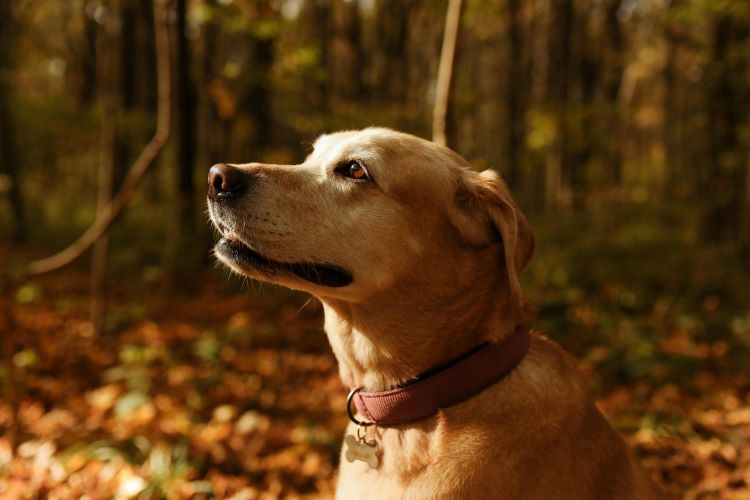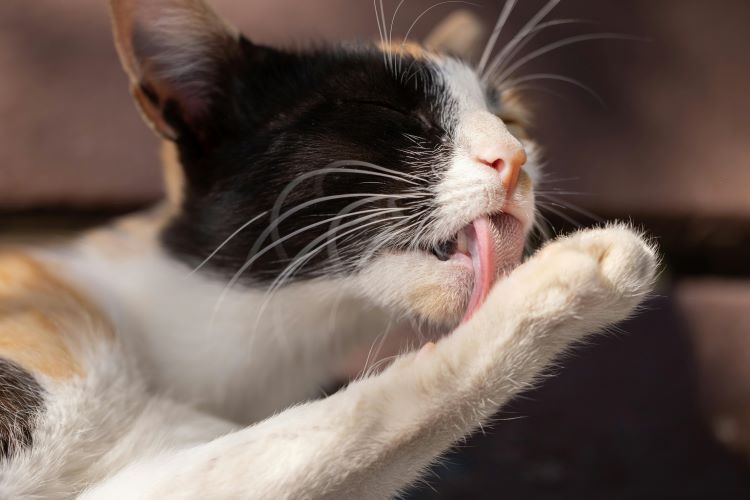Ready to help treat your pet to a healthy life?
Seasonal Sniffles in Pets? What to Know About Fall Allergies in Dogs & Cats
By : Brianna Gunter | Published Oct 30, 2025

Goodbye, summer. Hello, fall! As autumn arrives and the leaves begin to change, many of us look forward to cooler temperatures and cozy weather with our pets. But, wait, are you prepared to deal with seasonal allergies? No, not just with humans — this may come as a surprise, but dogs and cats can suffer from fall allergies as well.
That’s right! Many pet owners are under the impression that allergies only tend to occur in pets during the summer and spring, but the reality is that they are very common (in dogs especially) during the fall months. While allergies are technically present year-round, seasonal changes (like the shift into fall) bring an increase in allergens that can affect pets and humans alike. And as some newer research suggests, fall allergies are becoming more common thanks to climate change.
Not everyone is affected, of course. But among the people and animals who are, fall allergies can cause major discomfort and, in some cases, lead to more serious health issues if not addressed. There’s a lot of information around already about human allergies, but it’s only recently that autumnal allergies in pets have become more understood. Fortunately, taking some time now to learn the causes, recognizing the symptoms, and knowing how to manage fall allergies can help you keep your pets healthy and comfortable during this season.
What causes fall allergies in pets?
Fall allergens that affect dogs and cats are often similar to those that commonly affect humans. It’s worth noting that your own pet may be susceptible to allergens other than those listed below. This is why it’s important to talk with your veterinarian and provide as much information as possible on their symptoms and when they’re experiencing them.
In the meantime, the most common allergens for pets this time of year include:
- Ragweed — One of the primary culprits of seasonal allergies in both pets and humans is ragweed pollen. Ragweed thrives in fall, releasing pollen into the air. This allergen can stick to your pet’s fur and skin, causing allergic reactions.
- Mold spores — With falling leaves and decaying plant matter, mold grows more abundantly in damp areas during the fall. Pets that spend time outdoors may come into contact with mold spores, either through inhalation or skin contact.
- Dust mites — As homes start to get cozier with the use of heaters, dust mites can thrive indoors. These tiny pests often cause allergic reactions in pets, leading to skin irritation or respiratory issues.
- Flea allergies — While fleas can be a year-round problem, they tend to be more active during the fall, especially in humid climates. Some pets are allergic to flea saliva, leading to intense itching and skin irritation even from just a few bites.
- Outdoor pollutants — Smoke from bonfires, increased use of fireplaces, and other outdoor pollutants can exacerbate allergies in sensitive pets. The dry air combined with airborne particles can cause respiratory distress and worsen allergy symptoms.
Common signs of fall allergies in dogs and cats
Unlike humans, who often exhibit sneezing, congestion, and itchy eyes, dogs and cats tend to show allergic reactions primarily through their skin. This makes it essential for pet owners to pay close attention to subtle changes in behavior and appearance during allergy season.
Symptoms can vary between different pets, including among different breeds. For example, nasal and eye symptoms may be more apparent in brachycephalic pets (those with short, flatter faces). The most common signs of allergies in pets to look for include:
- Excessive scratching or biting
- Red or inflamed skin
- Hair loss/thinning (may be caused by excessive scratching or biting)
- Ear irritation (noted by redness, itching, head shaking, etc.)
- Watery eyes
- Sneezing
- Paw licking

Diagnosing seasonal allergies in pets
If you suspect your dog or cat has fall allergies, it's important to make an appointment with your veterinarian. Only they will be able to give a proper diagnosis and determine what kind of treatment may help ease your pet’s symptoms. They may perform a physical examination and review your pet’s medical history to rule out other potential causes of the symptoms.
Nevertheless, diagnosing fall allergies in dogs and cats can be difficult. This is especially true if your pet is no longer experiencing the same symptoms they were earlier when you made the appointment. In these situations, your veterinarian may opt for more testing to get to the bottom of things.
Pet allergy tests
Blood tests or intradermal skin tests can help identify specific allergens that are triggering your pet’s symptoms. This can be especially helpful if your pet’s symptoms are persistent or severe.
Elimination diet
Sometimes, food allergies can be mistaken for seasonal allergies. Your vet might suggest an elimination diet to rule out food as the culprit before focusing solely on environmental allergens.
Treatment and prevention
Once you know what’s causing your pet’s allergies, there are several ways to help alleviate their discomfort and manage the symptoms. It’s also a good idea to take steps to prevent allergies both during and before the fall season starts.
1. Keep your home clean
Regularly vacuum your home, especially in areas where your pet spends most of their time, to remove allergens like dust mites and pollen. Wash your pet’s bedding frequently in hot water to kill dust mites and remove outdoor allergens. Be sure to use pet-friendly cleaning products while you’re at it!
2. Bathe your pet regularly
Bathing your dog or cat with a hypoallergenic, soothing shampoo can help remove pollen, mold, and other allergens from their coat. Be sure not to overdo it though. Bathing your pet too frequently can strip natural oils from the skin and worsen dryness or irritation.
3. Consider antihistamines
While not approved by the FDA for use in animals, over-the-counter antihistamines like Benadryl can help alleviate mild allergy symptoms in some pets. Always get approval from your veterinarian before giving any medication to ensure proper dosage and safety. It should go without saying, but never give your pet any medication without first consulting with your vet.
4. Practice parasite prevention
Use parasite prevention treatments regularly, especially in the fall. As the weather cools down, this is when these unsavory beings may be more inclined to find their way indoors and onto your pet. Flea prevention should be practiced monthly with both dogs and cats (including indoor-only pets) to reduce the likelihood of flea bites and flea-induced allergic reactions.
5. Adjust your pet’s diet
Incorporating omega-3 fatty acids into your pet’s diet can help reduce inflammation and improve skin health (relieving dry, itchy skin caused by fall allergies). Look for dog or cat foods with this added, or talk with your veterinarian about possible pet-friendly supplements to add to their current food.
6. Ask about allergy shots or immunotherapy
For pets with severe allergies, your veterinarian may recommend immunotherapy, which involves administering small doses of the allergen over time to help desensitize your pet’s immune system. Some allergy shots may also be available to help relieve symptoms in pets with more severe allergic reactions in fall.

For allergies that are not pre-existing in dogs and cats, pet insurance can help cover the cost of treatment.
